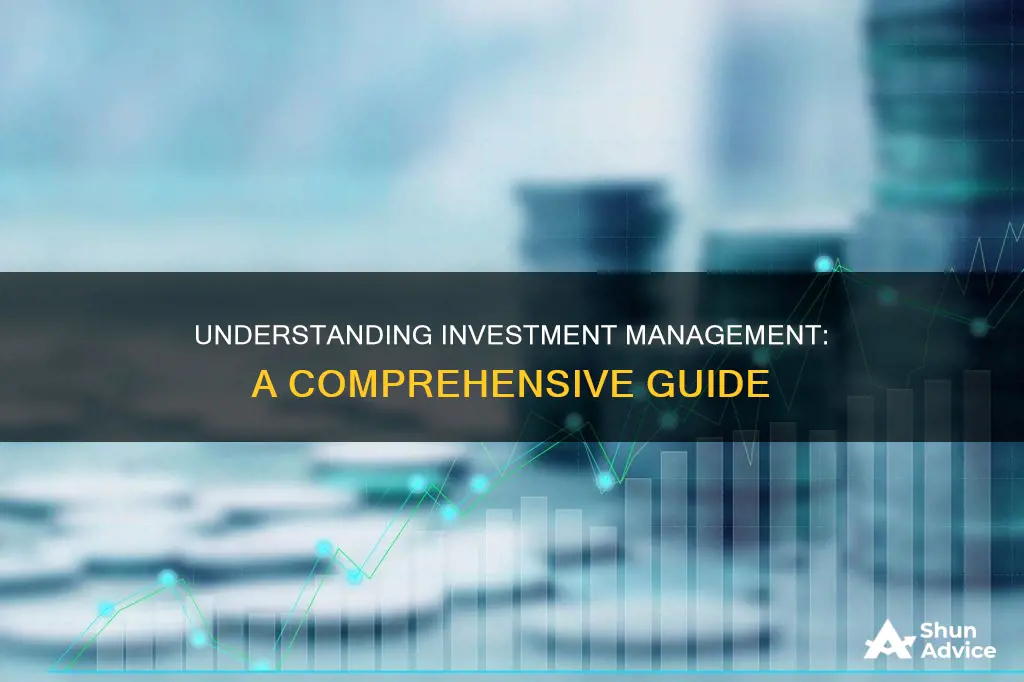
Investment management is the process of employing funds with the aim of achieving additional income or growth in value. It involves the commitment of resources that have been saved or put away from current consumption in the hope that benefits will accrue in the future.
Investment management can be broken down into two types: economic investment and financial investment. Economic investment refers to the net additions to the capital stock of a society, which are used in the production of other goods and services. Financial investment involves the allocation of monetary resources to assets that are expected to yield a gain or positive return over time.
There are several types of investment, including:
- Autonomous investment
- Induced investment
- Financial investment
- Real investment
- Planned investment
- Unplanned investment
- Gross investment
- Net investment
What You'll Learn

Introduction to Investment Management
Investment management is the process of managing one's funds with the aim of achieving additional income or growth in value. It involves the commitment of resources that have been saved or kept aside from current consumption with the hope of accruing benefits in the future.
Investment Defined
- Financial Meaning: Investment is the commitment of a person's funds to derive future income in the form of interest, dividends, premiums, pension, or appreciation in the value of their capital.
- Economic Meaning: Investment refers to the net additions to the economy's capital stock, which consists of goods and services used in producing other goods and services.
Characteristics of Investment
- Return: The expectation of a positive rate of return is an essential element of investment.
- Risk: The level of risk associated with an investment.
- Safety: The security of the investment principal.
- Liquidity: The ease of converting the investment into cash.
Investor's Point of View
From the investor's perspective, an investment involves committing funds with the goal of deriving future income. This can be in the form of interest, dividends, rent, premiums, pension benefits, or appreciation in the value of the capital. The use of money is not as important as the potential for future income. Most financial investments are considered transfers of financial assets from one person to another.
Types of Investment
- Economic Investment: Refers to the net additions to the capital stock of society, including goods and services used in production.
- Commitment Investment: Refers to the commitment of money to satisfy personal desires, without an expected rate of return or capital growth.
- Financial Investment: Involves investing funds in various assets such as stocks, bonds, real estate, etc.
Investment Instruments
There are two main categories of financial securities:
- Debt Instruments: Commercial paper, bankers' acceptances, treasury bills, mortgage loans, bonds, and debentures.
- Equity Instruments: Common stock.
Investment Management Process
The investment management process typically includes the following steps:
- Investment Policy: Identifying investment assets and considering various features of investments.
- Investment Analysis: Analysing and valuing securities available for investment.
- Portfolio Construction: Selecting and allocating investments to create a diversified portfolio that meets the investor's objectives.
Benefits of Investment Management
Effective investment management offers several advantages:
- Professional Management: Access to expert knowledge and skills in managing investments.
- Diversification: Spreading investments across different assets and sectors to reduce risk.
- Convenience: Saving time and effort by having professionals manage your investments.
- Potential for Higher Returns: Utilising advanced investment strategies and research to maximise returns.
- Liquidity: Providing flexibility to access and withdraw funds when needed.
- Transparency: Clear understanding of investment performance and risks.
Savings: Invest Today, Secure Your Future
You may want to see also

Types of Investment
There are several types of investment, each with its own unique characteristics and risk factors. Here is a detailed overview of some common types of investment:
- Economic Investment: This refers to the net additions to the capital stock of a society, which consists of goods and services used in producing other goods and services. In other words, it involves increasing the amount of buildings, plants, equipment, and inventories beyond what already exists.
- Commitment Investment: This type of investment involves committing money to satisfy personal desires, without expecting any rate of return or capital growth. For example, purchasing a new car can be considered an investment from an individual's perspective.
- Financial Investment: Financial investment involves putting money into various assets such as stocks, bonds, and real estate. It is a long-term commitment of funds with the aim of achieving additional income or growth in value. This type of investment carries a certain level of risk and typically requires waiting for rewards in the future.
- Autonomous Investment: Autonomous investment is independent of an individual's income level. It remains constant regardless of changes in income.
- Induced Investment: Induced investment is directly related to changes in income level. As income increases or decreases, induced investment varies accordingly.
- Real Investment: Real investment is made in physical assets such as new plant and equipment. It often involves investing in long-term, tangible assets that are used in the production process.
- Planned Investment: Planned investment involves allocating funds to various sectors of the economy based on a pre-determined plan. It is done with a strategic approach and long-term goals in mind.
- Unplanned Investment: Unplanned investment, as the name suggests, is done without any formal planning. It may be reactive or opportunistic in nature.
- Gross Investment: Gross investment refers to the total amount spent on creating new capital assets during a specific period. It includes all expenditures on fixed capital, such as buildings, machinery, and equipment.
- Net Investment: Net investment is calculated by subtracting capital consumption (depreciation) from gross investment. It represents the actual addition to the capital stock during a given period.
These types of investments vary in terms of risk, return potential, liquidity, and time horizon. Each type serves a different purpose and is suitable for investors with diverse financial goals and risk tolerances. It is essential for investors to understand the characteristics of each investment type before making informed decisions about their investment portfolios.
Answering Relationship Manager Questions: Investment Management Edition
You may want to see also

Investment Instruments
Equity-Based Securities
Equity-based instruments represent ownership of an asset. Stocks are the most common example of equity-based securities. When you buy a stock, you purchase a share of a company, becoming a shareholder. This means you own a fraction of the company's assets and earnings.
Common Stocks: Shareholders of common stocks have the right to vote on company matters, such as electing the board of directors. However, in the event of liquidation, they are the last to receive any remaining company assets.
Preferred Stocks: These stockholders typically don't have voting rights, but they receive dividends (a portion of the company's profits) before common stockholders. They also have a priority claim on assets if the company goes under.
Debt-Based Securities
Debt-based instruments are essentially loans made by an investor to the issuer in return for a payment of interest. Bonds are a typical example of debt-based securities. When you buy a bond, you lend money to the issuer, who promises to pay you periodic interest and return the principal amount at maturity.
Government Bonds: These are issued by national governments and are often seen as safe investments because they are backed by the government's full faith and credit.
Corporate Bonds: These are issued by businesses, and their risk varies based on the company's financial health and the bond terms.
Derivatives
Derivatives are financial contracts whose value is tied to the performance of an underlying asset, such as stocks, bonds, or commodities. They can be used for hedging (protection) or speculation (profit-making). Options, futures, and swaps are common types of derivatives.
Options: These contracts give the holder the right (but not the obligation) to buy or sell an asset at a predetermined price within a specific timeframe.
Futures: These are agreements to buy or sell an asset at a set price on a specific future date, regardless of the market price.
Swaps: These involve exchanging cash flows or other financial variables between two parties based on certain conditions or assets.
Money Market Instruments
Money market instruments are short-term financial instruments, typically with maturities of less than a year. They are used by companies and governments to meet short-term liquidity needs. Examples include treasury bills, commercial paper, and certificates of deposit (CDs).
Mutual Funds
Mutual funds pool money from multiple investors to invest in a diversified portfolio of stocks, bonds, or other assets. They are managed by professional fund managers.
Exchange-Traded Funds (ETFs)
ETFs are similar to mutual funds but are traded on stock exchanges. They offer more diversification and liquidity than mutual funds, allowing for intra-day trading. They also typically have lower fees.
How to Make Your Portfolio Invest Itself
You may want to see also

Investment Analysis
Understanding Investment Objectives
Before embarking on investment analysis, it is essential to define the objectives of the investment. This includes clarifying the investment time horizon, expected rate of return, risk tolerance, and any specific financial goals the investor aims to achieve.
Economic Analysis
Analysing the broader economic landscape is vital for investment decision-making. This entails evaluating macroeconomic factors such as interest rates, inflation rates, economic growth, and industry trends. Additionally, assessing the business cycle stage can provide insights into potential investment opportunities and risks.
Security Analysis
Security analysis involves evaluating the various types of securities available for investment, including stocks, bonds, mutual funds, and other financial instruments. It is important to understand the risks and returns associated with each security type, as well as their potential impact on the overall investment portfolio.
Fundamental Analysis
Fundamental analysis is a deep dive into the intrinsic value of a particular investment option, such as a company's stock. This analysis considers financial statements, competitive advantage, management effectiveness, and future growth prospects to determine the investment's worthiness.
Technical Analysis
Technical analysis, on the other hand, focuses on historical market data, such as price movements, trading volumes, and market trends, to identify patterns and make informed predictions about future price movements. Technical analysts use charts, indicators, and other tools to time their entry and exit points in the market.
Risk Analysis
Risk analysis is a critical component of investment analysis, as it helps investors understand the potential downsides of their investment decisions. This involves assessing different types of risk, such as market risk, liquidity risk, credit risk, and operational risk, and determining how these risks can be mitigated through diversification or other risk management strategies.
Portfolio Analysis
Portfolio analysis involves evaluating the performance and composition of an investor's existing portfolio. It helps identify areas of strength and weakness, ensuring the portfolio aligns with the investor's risk tolerance, return expectations, and financial goals.
Industry and Sector Analysis
Analysing specific industries and sectors can provide valuable insights for investment decisions. This includes assessing the competitive landscape, regulatory environment, technological advancements, and market trends within a particular industry or sector.
Valuation Techniques
Valuation techniques, such as discounted cash flow analysis, relative valuation, and dividend discount models, help determine the intrinsic value of an investment. These techniques enable investors to identify undervalued or overvalued investments and make more informed decisions.
Global Market Considerations
In today's interconnected world, it is crucial to consider global market dynamics and their potential impact on investments. This includes analysing international economic trends, geopolitical risks, and the performance of global financial markets.
Investor Behaviour and Psychology
Understanding investor behaviour and psychology is an important aspect of investment analysis. It involves recognising how investors' emotions, biases, and herd mentality can influence market movements and affect investment decisions.
Regulatory and Tax Environment
The regulatory and tax environment plays a significant role in investment analysis. Investors need to be aware of relevant laws, regulations, and tax implications that may impact their investment strategies and returns.
Investment Performance Measurement
Finally, measuring the performance of investments is essential for evaluating the success of investment decisions. This includes tracking returns, comparing them to relevant benchmarks, and analysing the factors contributing to investment gains or losses.
TD Ameritrade's Essential Portfolio: Where Does it Invest?
You may want to see also

Risk and Return Analysis
The Relationship Between Risk and Return
The general principle is that there is a positive correlation between risk and return. In other words, as the level of risk increases, so does the potential for higher returns or losses. This relationship is a foundational concept in financial theory. However, it's important to note that higher risk does not always guarantee more attractive returns.
Risk-Return Tradeoff
The risk-return tradeoff principle states that potential returns rise with an increase in risk. This means that individuals associate low levels of uncertainty with low potential returns and high levels of uncertainty or risk with high potential returns. According to this principle, invested money can yield higher profits only if the investor accepts a higher possibility of losses.
Types of Risk
When analysing risk, it is important to consider different types of risk. Standard Deviation, Beta, Maximum Drawdown, and Tracking Error are some of the measures used to quantify investment risk. Standard Deviation, for example, is a popular metric that indicates the volatility of an investment, with higher values signifying greater risk. Beta measures the sensitivity of an investment to market movements, with a value greater than 1 indicating higher sensitivity. Maximum Drawdown reflects the peak-to-trough decline in an asset's price, and larger values suggest higher risk. Tracking Error measures how much a portfolio's returns deviate from its benchmark.
Risk Management Strategies
Successful risk management involves identifying and analysing the sources of risk and making informed decisions. Some common risk management techniques include:
- Avoidance: This involves choosing the safest assets with minimal to no risks.
- Retention: Accepting risks as a trade-off for the potential of high returns.
- Sharing: Distributing risk among multiple parties.
- Transferring: Passing the risk from one party to another, such as through insurance.
- Loss Prevention and Reduction: Balancing volatile investments with more conservative choices to mitigate overall risk.
Factors Affecting Risk-Return Analysis
When conducting risk-return analysis, investors should consider various factors, including their risk tolerance, years to retirement, and the potential to replace lost funds. Time plays a crucial role, as investing in equities over the long term provides a better opportunity to recover from bear markets and participate in bull markets. Additionally, the specific features of the portfolio, such as diversification and industry focus, can impact the risk-return profile.
Calculating Risk-Return
To calculate risk-return, investors can use metrics such as the Alpha ratio, Beta ratio, and Sharpe ratio. The Alpha ratio measures excess returns on an investment compared to a benchmark. The Beta ratio assesses the correlation between a stock and the overall market (usually the S&P 500). The Sharpe ratio helps determine if the investment risk is worth the potential reward.
Risk and Return Models
Several models are available to help investors assess and manage risk and return, including:
- Capital Asset Pricing Model (CAPM): This model helps determine the expected return on an investment given its level of risk.
- Arbitrage Pricing Theory (APT): This model considers multiple sources of risk (factors) and their sensitivity to determine the expected return of an asset.
- Fama-French Three Factor Model: Developed by Eugene Fama and Kenneth French, this model uses three factors, including market risk premium and the performance of small and large market capitalisation companies, to predict asset returns.
In conclusion, risk and return analysis is a critical component of investment management. By understanding the relationship between risk and return, investors can make more informed decisions, balance their portfolios, and strive for optimal outcomes.
Savings, Investment, and Productivity: The Interplay for Economic Growth
You may want to see also
Frequently asked questions
Investment management is the process of managing investor funds through securities such as bonds, stocks, commodities, currencies, mutual funds, exchange-traded funds, and more to achieve investment goals.
There are two major categories of financial securities: debt instruments and equity instruments. Examples of debt instruments include commercial paper, bankers' acceptances, treasury bills, mortgage loans, bonds, and debentures. Examples of equity instruments include common stock.
Investment management offers individuals access to diversified, professionally-managed portfolios of securities. It also helps individuals and businesses achieve their financial goals by providing a wide range of investment options and strategies to choose from.







